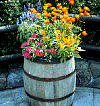 If
lack of space is the only reason for not having a vegetable garden, you
no longer have an excuse. Plant breeders and seed companies are offering
a wide variety of vegetables that are suitable for containers. Even apartment
dwellers with only a balcony can enjoy fresh vegetables grown by their
own hands. Any space with ample light and access for watering and fertilizing
is appropriate for container gardening, including a window sill, patio,
doorstep, or rooftop. One advantage of gardening in containers is freedom
from soil-borne diseases, insects, nematodes, and poor soil, all of which
threaten plants in a traditional garden.
If
lack of space is the only reason for not having a vegetable garden, you
no longer have an excuse. Plant breeders and seed companies are offering
a wide variety of vegetables that are suitable for containers. Even apartment
dwellers with only a balcony can enjoy fresh vegetables grown by their
own hands. Any space with ample light and access for watering and fertilizing
is appropriate for container gardening, including a window sill, patio,
doorstep, or rooftop. One advantage of gardening in containers is freedom
from soil-borne diseases, insects, nematodes, and poor soil, all of which
threaten plants in a traditional garden.
 There
are three important considerations when choosing containers; they must
1) be large enough to support fully grown plants, 2) have adequate drainage,
and 3) never have held products that are toxic to plants or people. A wide
variety of containers can be used including hanging baskets, clay or plastic
pots, barrels, trash cans, milk containers, and bushel baskets or wooden
crates lined with plastic punched with drainage holes. Even drain pipes
and cement blocks have been used to grow vegetables! When using wood products,
it is important to avoid those treated with creosote or pentachlorophenol
(Penta). These treatments are toxic to plants.
There
are three important considerations when choosing containers; they must
1) be large enough to support fully grown plants, 2) have adequate drainage,
and 3) never have held products that are toxic to plants or people. A wide
variety of containers can be used including hanging baskets, clay or plastic
pots, barrels, trash cans, milk containers, and bushel baskets or wooden
crates lined with plastic punched with drainage holes. Even drain pipes
and cement blocks have been used to grow vegetables! When using wood products,
it is important to avoid those treated with creosote or pentachlorophenol
(Penta). These treatments are toxic to plants.
Containers that drain poorly can mean the failure of a container garden.
Always be sure there are plenty of drainage holes in the bottom or along
the sides of the container. It is a good idea to raise containers off the
ground with slats or bricks to allow excess water to drain freely.
As for container size, there are no hard and fast rules to follow. A
general guide is to use small containers (about 1 to 2 gallons) for lettuce,
spinach, mustard, peppers, radishes, green onions, carrots, beets, broccoli,
beans, and dwarf tomatoes; use medium containers (about 3 to 10 gallons)
for eggplants and for larger crops of any of the vegetables listed above;
and use large containers (greater than 10 gallons) for cabbage, brussels
sprouts, cucumbers, squash, and tomatoes. For most vegetables, starting
with transplants will be faster and easier than seed.
It is possible to give a plant maximum sunlight or to avoid damage from
rough weather by moving it to a different location when necessary. Remember:
larger pots will be quite heavy, especially after watering. Use dollies
or platforms with wheels to move them. Soil used in containers must be
porous to ensure air and water movement around the roots for good plant
health and productivity. Regular garden soil does not drain well in containers
and should not be used. Potting soil appropriate for containers can be
purchased at local garden centers, or you can mix your own with one part
compost; one part garden loam; and one part clean, coarse, builder's sand
or perlite. A slow-release fertilizer may also be added to this mix.
Watering is very important. Containers dry out quickly, especially in
full sun and wind. Clay pots, due to their porous nature, allow additional
evaporation from the sides. Pots should be watered thoroughly until water
runs out the bottom. However, the pot should not be left standing in water.
Soil should be checked for moisture at least once a day, and in hot, dry
weather, twice a day. Plants should be watered if the soil is dry an inch
below the surface.
Excessive watering can be as fatal as too little because there will
not be sufficient oxygen
Vegetables grown for their roots (beets, carrots, and radishes) will
tolerate partial shade, as will leafy vegetables. Don't overlook the tops
of beets as a delicious green. Most other vegetables bearing fruit require
at least six hours of direct sunlight a day.
When given the proper care, a container garden can be every bit as satisfying
and enjoyable as a traditional one.
(Originally published as "Small Space and Container Gardening," by Ellen
S. Bennett)